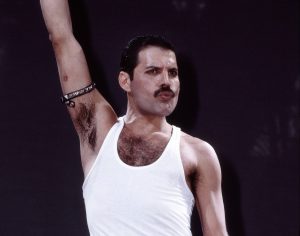7 Times Rock Artists Unexpectedly Went Pop — And Nailed It

YouTube via @aerosmith
Rock has always thrived on rebellion, but sometimes that rebellion means breaking away from its own walls. Over the years, a handful of rock artists have dared to step into the glossy, synth-laden world of pop—often to the shock of their die-hard fans. What started as experiments or detours turned into career-defining moments that blurred genre lines and reshaped how we define “rock credibility.”
These crossovers weren’t just about chasing trends or radio hits. Many of these musicians found new creative freedom in pop, discovering melodies and production styles that rock’s boundaries once restricted. Their songs lit up dance floors, topped charts, and reached entirely new audiences, proving that pop’s accessibility didn’t have to come at the expense of artistry.
What’s more, these unexpected shifts often came at critical points in their careers—times when reinvention wasn’t just exciting, but necessary. Whether through a polished production, a daring collaboration, or a complete image overhaul, these artists proved that venturing into pop didn’t mean selling out. It meant leveling up.
Rod Stewart – “Do Ya Think I’m Sexy?” (1978)
When Rod Stewart swapped his bluesy rock roots for a glossy disco sound, few saw it coming. The raspy-voiced rocker traded his familiar guitars and raspy charm for danceable grooves and satin-shirt swagger. What could have been a disaster instead became a global phenomenon, topping charts from the U.K. to the U.S. and turning every dance floor into a party.
At the time, critics accused Stewart of abandoning his roots for commercial gain. The backlash was loud, with many fans branding him a sellout for embracing the glitzy disco trend. Yet the irony was that Stewart had always been a shape-shifter — from folk to rock to pop — and this was just another reinvention.
Decades later, “Do Ya Think I’m Sexy?” stands as a timeless guilty pleasure. It’s been sampled, remixed, and celebrated in pop culture, proving that Stewart’s risk paid off. What once shocked rock purists became a defining moment in his career — one that showed just how fearless he could be.
Heart – “These Dreams” (1985)
By the mid-1980s, Heart had weathered lineup changes and shifting trends that nearly ended their momentum. Then came “These Dreams,” a shimmering power ballad that swapped their fierce rock riffs for lush synthesizers and sentimental storytelling. Sung by Nancy Wilson, it gave the band a softer, dreamier sound that resonated with both pop and rock audiences.
The song was a dramatic shift from their earlier anthems like “Barracuda,” but it marked a turning point rather than a betrayal. Heart embraced the sleek production style of the decade — layered keyboards, soaring vocals, and heartfelt lyrics — and in doing so, they found a second wind.
“These Dreams” became Heart’s first No. 1 hit, solidifying their comeback and proving that reinvention could be a strength, not a compromise. It also opened the door to a string of chart successes that kept them relevant well into the MTV era.
KISS – “I Was Made for Lovin’ You” (1979)
KISS had already conquered rock with face paint, fire-breathing, and unforgettable riffs, but disco was the last thing anyone expected from them. “I Was Made for Lovin’ You” changed that instantly. With its thumping bass line, steady four-on-the-floor beat, and Paul Stanley’s falsetto chorus, it was a song made for nightclubs, not arenas — and fans didn’t know what to think.
Some hardcore followers felt betrayed, accusing the band of selling out to trends. Yet the track’s infectious rhythm and polished production turned it into an undeniable hit, racing up charts worldwide. Even the band’s critics couldn’t resist its pulse.
Over time, “I Was Made for Lovin’ You” became one of KISS’s defining songs — not just a disco experiment but proof of their knack for tapping into what made people move. Whether blasted from a stadium stage or a dance floor, it’s still impossible not to sing along.
Queen – “Another One Bites the Dust” (1980)
Queen had always pushed boundaries, but “Another One Bites the Dust” took their experimentation to new heights. Inspired by the groove of Chic’s Bernard Edwards and Nile Rodgers, bassist John Deacon crafted a bassline that blended funk, disco, and pop with Freddie Mercury’s commanding swagger. It was minimalist, rhythmic, and unlike anything else in rock at the time.
The song’s slick production and dance-floor appeal caught audiences off guard, but it became an instant crossover hit. Suddenly, Queen were not just rock icons — they were dominating R&B stations and clubs across America. Even Michael Jackson reportedly encouraged them to release it as a single, sensing its universal appeal.
The result was staggering. “Another One Bites the Dust” became Queen’s best-selling single and remains one of their most recognizable songs. Its success proved that rock could groove without losing its edge — and that Queen’s genius lay in their refusal to stay in one lane.
Aerosmith – “I Don’t Want to Miss a Thing” (1998)
By the late ’90s, Aerosmith had already survived decades of excess, breakups, and comebacks. Then came an unexpected hit that would redefine them yet again. “I Don’t Want to Miss a Thing,” written by hitmaker Diane Warren and featured in the film Armageddon, was pure pop power balladry — soaring strings, emotional vocals, and zero distortion.
It was a far cry from their swaggering blues-rock sound, and longtime fans weren’t sure what to make of it. But Steven Tyler’s heartfelt delivery turned it into an anthem for a new generation, one that introduced Aerosmith to audiences who had never heard “Sweet Emotion.”
The gamble paid off. The song shot to No. 1 on the Billboard Hot 100, becoming the biggest hit of their career. It may have divided purists, but it also cemented Aerosmith’s reputation as a band unafraid to evolve — proving that even the toughest rockers have a soft side.
Bon Jovi – “It’s My Life” (2000)
By the turn of the millennium, Bon Jovi were facing the challenge that every veteran rock band eventually encounters — staying relevant in a changing musical landscape. Gone were the days of teased hair and leather jackets; the late ’90s demanded something sleeker, more anthemic, and radio-ready. “It’s My Life” arrived as the perfect answer. With its pulsing rhythm, catchy hook, and a lyric that spoke directly to a new generation’s sense of independence, it became a global anthem almost overnight.
The song blended classic Bon Jovi energy with modern production, thanks in part to producer Max Martin, who brought a pop sheen that fit seamlessly with Jon Bon Jovi’s defiant vocals. It was both nostalgic and forward-thinking — a song that honored their roots while embracing a broader, more polished sound.
“It’s My Life” reignited Bon Jovi’s career and solidified their presence in the 2000s. It reminded fans that rock could evolve without losing its heart — and that a great anthem, no matter how glossy, still hits hardest when it’s built on raw conviction.
Fleetwood Mac – “Everywhere” (1987)
By 1987, Fleetwood Mac had weathered enough internal storms to sink most bands. After the emotional turbulence of Rumours and Tusk, their sound took a gentler, dreamier turn with “Everywhere.” Christine McVie’s soft, melodic vocals floated over airy synths and a hypnotic rhythm, creating one of the most blissful pop moments of the decade.
This wasn’t the biting, confessional storytelling that had defined their earlier work — it was something brighter and more romantic. The song’s production shimmered with the optimism of the late ’80s, capturing a sense of warmth and escapism that felt worlds away from their past heartbreaks.
Over time, “Everywhere” became one of Fleetwood Mac’s most beloved tracks, cherished by longtime fans and rediscovered by new ones through films, commercials, and streaming playlists. Its staying power lies in its simplicity — proof that when great songwriters embrace pop, they can still create magic that transcends trends.


















